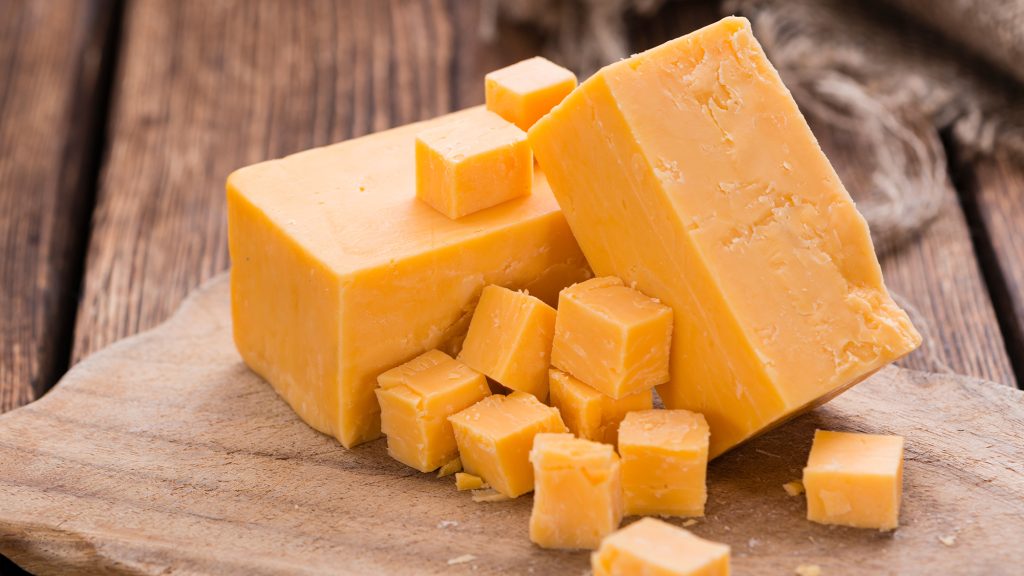This article is part of our Cocktail Chatter series, where we dive into the wild, weird, and wondrous corners of history to share over a cocktail and impress your friends.
The average consumer seldom questions the differences between cheese varieties. Brie is soft. Parmesan and aged Gouda are hard. Some contain streaks of blue mold, and some don’t. As long as it tastes good, who really cares? But not all cheese is created equally, and for that matter, some varieties don’t just get their looks from farm-to-rind practices.
This is particularly relevant when discussing cheddar, the lifeblood of the British cheese industry. While some cheddars are white, others are bright orange. What’s the deal? If cheese comes from milk, which is as white as printer paper, why do some cheddars bear a Day-Glo orange hue?
Nefarious Pastures
The reason traces back to 17th-century England. There, much of the grass is high in beta-carotene levels — the same pigment that gives carrots their orange color — so when dairy farmers would let their cattle graze outdoors in the spring and summer months, the pigment would transfer over to the cows’ milk. According to NPR, this color became a mark of quality.
However, English dairy farmers weren’t just making cheese. Butter was also a major source of income, and since the beta-carotene ends up in the cow’s milk’s fatty cream, the farmers started to skim off the cream to make butter — and subsequently boost their bottom lines.
Naturally, their cheddar lost its iconic color and some of its fat content. So, to keep giving customers what they had come to expect from a visual standpoint, dairy farmers began coloring their white cheddars with everything from marigold flowers and saffron to carrot juice and annatto, a food coloring agent derived from the seeds of the Latin American achiote tree. Eventually, annatto became the primary substance used for coloring otherwise white cheddars, mainly because it doesn’t impart any additional flavor.
All Annatto Everything
It wasn’t just cheddar that started getting the annatto treatment. Dairy farmers in the Netherlands have since started putting it in Gouda (reports of when this practice began vary). In the 1800s, producers in the U.K. began adding the stuff to Leicester cheese, hence why it’s now called “Red Leicester.” And later that century, Colby cheese was invented in Wisconsin, and colored with annatto from the get-go. That packet of orange powder that comes in boxes of Kraft Mac & Cheese? There’s annatto in there, too. The practice became a sort of unquestioned tradition that trickled into other countries over time.
It wasn’t just tradition that encouraged producers to add annatto to their cheeses. As was the case with Leicester, dairy farmers sought a way to make their cheese stand out on the shelf next to other eye-catching varieties like Stilton. It also became an essential ingredient for achieving a consistent color between batches, since the cheese fluctuates in hue depending on whether cattle are feeding on grass in the hotter months or eating hay and grains in the winter. Just like fresh fruits and veggies, cheese is a seasonal product.
Although adding annatto to cheese is fairly common throughout the U.S., dairy farmers in New England have largely refrained from indulging in the practice. “Here in New England there was a disdain for brightly colored cheese,” Paul Kindstedt, food science professor at the University of Vermont, told NPR. That’s why most Vermont cheddar bears a pale white hue. However, with many cheesemakers now producing cheeses from grass-fed cows, it’s not uncommon to see some cheddars with a butter-like, golden color — sans annatto — especially during the late-summer months.
*Image retrieved from HandmadePictures via stock.adobe.com
The article Why Is Some Cheese Bright Orange? The Answer Lies in 17th-Century Dairy Fraud appeared first on VinePair.
